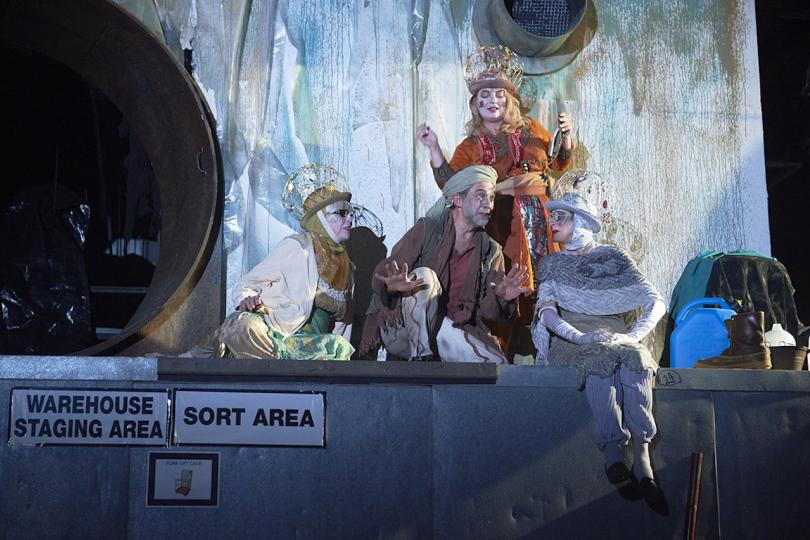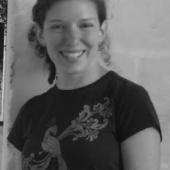Good People of Rainbow Foods

In theater, space goes a long way towards generating magic, and unlikely though it may be, there is a lot of magic in the abandoned Rainbow Foods on Lake Street. Some of the mood is generated before you even step inside the old grocery store, as you park in the big lot between the Wendy’s, the Denny’s, and the GM Tobacco. This is theater about the masses, not the upper crust, and I suspect that Frank Theatre, who has taken up residence in the space for their production of Bertolt Brecht’s The Good Person of Setzuan, would like to be making theater for the masses as well (although their $25 ticket prices may be a deterrent).
There is something unsettling about walking through the vacant grocery store, with the residue of old shelving units and check-out lines still marking the tiled floor – and it is even more unsettling that Frank has populated the space with an empty tent city, presumably for the poor denizens of Brecht’s Setzuan. The visual effect is cool, but it hits disconcertingly close to home, since it’s very believable that this Rainbow could (or should) actually house squatters when not in use as a theater. Given that Brecht’s whole goal is to provoke political reflection, however, this discomfort is probably part of the point.
Loading the play
In any case, the play itself takes place in the store’s loading dock, which is both a more intimate and more interesting space, with its platforms and openings of various levels for the actors to play on. It also wasn’t lost on me that the loading dock is where the hardest manual labor would have taken place in Rainbow Foods, making it an apt setting for a play about the struggles of exploited workers.
It is a tribute to both the production’s design and its acting that despite its three-hour run time and multiple scene changes, the most problematic part of the show was only the very uncomfortable seats. Starting from the Rainbow’s unusual ambiance, director Wendy Knox has staged an engaging show that doesn’t lose focus. Mike Wangen’s lighting design, which makes smart use of the loading dock’s odd geometry, and Kathy Kohl’s colorful costuming go a long way towards creating visual cohesion between the characters and the space.
Good Person’s central plot line is deceptively simple. A parable about the difficulty of being good in a corrupt society, the play opens with the news that a trio of gods will be arriving in Setzuan. These enlightened beings – played with delightful eccentricity by Katherine Ferrand, Janis Hardy, and Ellen Apel – are in search of a good person who abides by their laws. They find this good person in Shen Te, a prostitute who agrees to house them for the night. But after the gods reward her with 1000 silver dollars, Shen Te finds herself put upon from all sides. Her innate sense of generosity and morality lands her in such dire straits that she invents an alter-ego, the shrewd businessman Shui Ta, to get herself out of the messes created by her own desire to do good.
Humor, song, and lots of questions
On the surface a play about the corrupting power of money, Good Person also brings up interesting questions about where to place blame and who, in fact, benefits from ostensibly “good” actions. In true Brechtian style, some of the most pointed questions are asked through humor and song. Dan Dukich’s music and the comedic performances by Adan Varela and Virginia S. Burke were all highlights of the production, adding some levity and changes of pace to the main characters’ moral quandaries.
The central characters are also played with engaging specificity while never falling back into realism (which would have defeated the play’s purpose as a parable). John Middleton is excellent as Shen Te’s self-serving, charismatic love interest, and Patrick Bailey makes his role as the water seller into much more than just a narrator. Emily Grodzik also does an admirable job at believably knitting together Shen Te’s impossibly naïve goodwill and Shui Ta’s cutthroat business acumen.
With such a fine cast and design team to bring the play to life, the thorny issues around Good Person’s setting are also in sharp relief. After the departure of the gods, the play’s epilogue entreats the audience to build a better world that allows for goodness without placing individuals at the mercy of capitalist interests.
But this entreaty raises yet more questions when it is performed in a defunct business that must have laid off a number of employees when it closed its doors. How would those employees feel about the play being staged in their former workplace? Do the patrons of the nearby Wendy’s even know that there is theater being made right across the parking lot, and if so, do they feel welcome to come enjoy it?
The Frank Theatre has built a rich, interesting world inside the old Rainbow, inhabited as it is by the ghosts of tired cashiers and underpaid stockroom employees, and now brought to life by the fine performances of a group of hardworking actors. Outside of the Rainbow’s familiar sliding doors, we all struggle to be good in a world governed by money. Brecht doesn’t give us any easy answers, but he invites us to ask the right questions.




